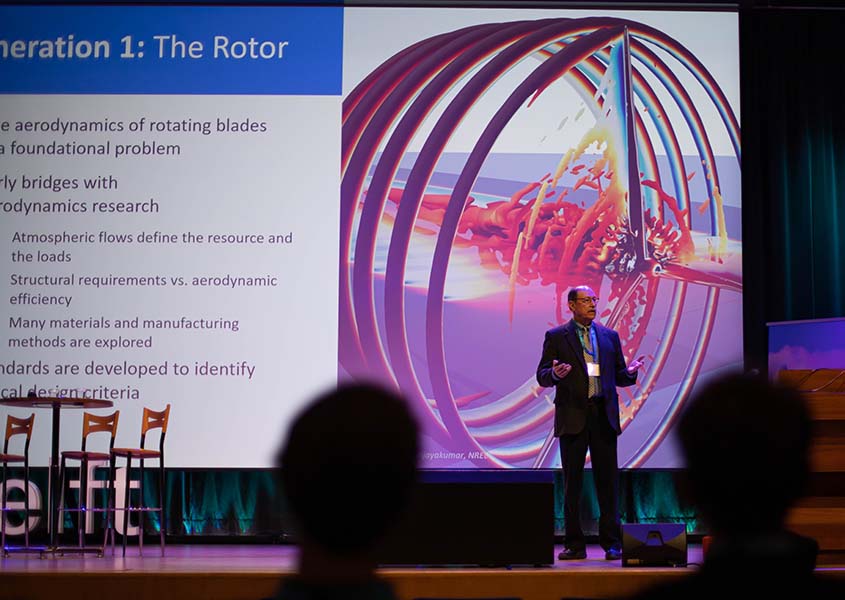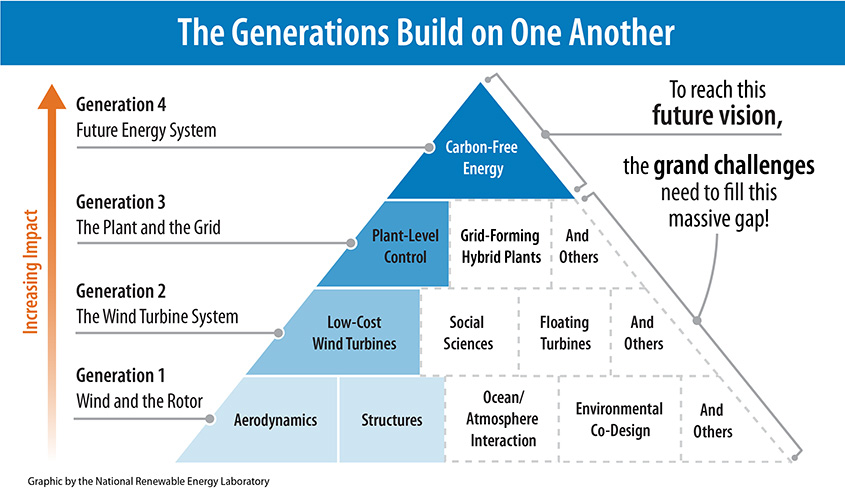Global Researchers Revisit Grand Challenges of Wind Energy Science
NREL Leads Article Series To Review Wind Energy Research Needs and Propose Actions To Help Reach Worldwide Decarbonization Goals

In his keynote speech at the 2022 Science of Making Torque conference, NREL Research Fellow Paul Veers recapped wind energy research needs for a global energy transition. Image from Blauw Helder Media
Wind energy will play a central role in shifting the world’s electricity supply to renewable sources within the next two decades. For wind power to fulfill this role, critical challenges around the design, development, and deployment of land-based and offshore wind energy must be addressed.
“To achieve worldwide decarbonization goals, we’re asking wind energy to increase its power-generation contribution from its current level of 5% to 35%‒50% or more of future electricity demand. This will require research, design, and development of wind power plants at scales and in locations where we have little experience,” said National Renewable Energy Laboratory (NREL) Research Fellow Paul Veers. “The good news is that the research community has developed a plan to address the scientific and technological challenges—which are surmountable with appropriate investments.”
In an expression of consensus around these critical challenges, Veers and other NREL researchers joined 100 worldwide wind energy experts in writing a series of 10 articles for publication in Wind Energy Science. With the support and guidance of the European Academy of Wind Energy Publications Committee, the articles summarize and clarify the most critical needs for the advancement of wind energy science. Some articles have already been published; others are planned for submission during the coming months.
Veers recently coauthored a perspective piece for Wind Energy Science that explains the origin and importance of these efforts.
The Grand Challenges Genesis
This collaborative effort began several years ago at an International Energy Agency Wind Technology Collaboration Programme Topical Experts Meeting that assessed the “grand challenges” for wind energy to meet its full potential. These challenges include the:
- Physics of atmospheric flow, especially in the critical zone of wind power plant operation
- System dynamics and materials of wind turbines—the largest, most flexible machines ever built
- Optimization and control of fleets of wind power plants made up of hundreds of individual generators working to support the electric grid.
Veers and others later published a Science journal article outlining the progress, potential, and high-level scientific gaps in wind energy. The researchers also noted crosscutting opportunities in digitalization and integrated education.
“The Science article made the case that wind energy technology has grown in turbine sizes, plant scales, and grid impacts, which forces a reevaluation of the very scientific underpinnings of wind energy,” Veers said. “Wind energy systems are so interconnected that progress in any single area is insufficient. Continued progress requires attention to all three.”
Later, responses to the article pointed out that the focus on issues of the physical sciences missed equally critical areas related to environmental impact and social interactions.
“Physical, social, and environmental processes all interact in ways that influence the growth of wind energy. We are just now beginning to appreciate and understand these competing issues, not only for wind energy but for the energy transition to renewables in general,” Veers said. “Continued research within and among these disciplines is needed to drive customizable solutions that meet local needs and scale up to achieve regional and global decarbonization goals.”

This graphic illustrates the generations of wind energy development. Each generation’s achievements expanded wind energy’s impact (shown in the blue boxes on the left); however, in moving quickly from generation to generation, some underlying science was left unresolved (shown in the white boxes on the right). Generation 1 delivered working energy conversion systems, Generation 2 offers low-cost and reliable turbines, and Generation 3 is beginning to provide controllable wind plants that support the grid. The aspirational goal of Generation 4 is a carbon-neutral future energy system. Wind can be the foundation for the fourth generation, but not until the gaps left behind in the previous generations are addressed. Graphic by NREL
Taking the Grand Challenges to the Next Level
To articulate a more detailed and actionable set of recommendations, the original authors engaged a larger group of experts to review each grand challenge in more depth and provide recommendations for how outstanding issues, including environmental and social aspects, might be resolved.
The resulting collection of Wind Energy Science articles, listed below, captures the breadth of wind energy research needs and proposes actions to fill critical gaps and enable wind power to be a foundation for the energy system of the future.
Grand Challenge 1: The Atmosphere
The following Wind Energy Science articles focus on the challenge of atmospheric flow physics:
- “Impact of Atmospheric Turbulence on Performance and Loads of Wind Turbines: Knowledge Gaps and Research Challenges.” To achieve optimal wind turbine performance and reliability, the industry will require better characterization of turbulence and its effects under the wide range of atmospheric conditions in which wind plants are expected to generate power continuously and reliably.
- “Mesoscale Wind Plant Wakes.” Wakes, or regions of slower and more turbulent air downwind of wind turbines, need to be better understood, as does the impact on local climates that large-scale deployment of wind energy may introduce.
- “Scientific Challenges to Characterizing the Wind Resource in the Marine Atmospheric Boundary Layer.” The offshore wind environment needs greater definition and understanding to optimize offshore wind power plants for their local environments.
Grand Challenge 2: The Wind Turbine
The following Wind Energy Science article focuses on the challenge of wind turbine system dynamics and materials:
- “Grand Challenges in the Design, Manufacture, and Operation of Future Wind Turbine Systems.” The size and flexibility of modern wind turbines have pushed design beyond where assumptions and modeling tools were first established, which creates unprecedented risks. Researchers lack the experimental data at the large scale necessary to validate the models and materials used to develop innovative solutions for future wind energy systems.
- "Current Status and Grand Challenges for Small Wind Turbine Technology." While modern wind turbines have become by far the largest rotating machines on Earth, a renewed interest in small wind turbines is fostering energy transition and smart grid development. Small machines have traditionally not received the same level of design refinement as their larger counterparts, resulting in lower efficiency, lower capacity factors, and therefore a higher cost of energy.
Grand Challenge 3: The Plant and Grid
The following Wind Energy Science articles focus on the challenge of optimizing and controlling wind farm fleets:
- “Wind-Farm Flow Control: Prospects and Challenges.” Managing the air flow through wind power plants is a complex challenge but offers opportunities to evolve optimal plant design, enhance production, lower maintenance costs, and provide the controllability demanded by the larger energy system.
- “Grand Challenges of Wind Energy Science—The Grid.” A grid dominated by wind energy and solar power will impose system needs that will also challenge how we approach the design of individual turbines, wind power plants, hybrid power plants, and the grid itself.
Crosscut: Digitalization
The following Wind Energy Science article focuses on the challenge of digitalization:
- “Grand Challenges in the Digitalization of Wind Energy.” A future in which digitalization has made data accessible in the right places and at appropriate times has many valuable outcomes, but significant technical and cultural impediments must be resolved before this aspirational goal for wind energy can be achieved.
Beyond Technical Borders: Environmental and Social Issues
The following Wind Energy Science articles focus on the challenges of environmental and social impacts:
- “Interdisciplinary Research Challenges in Wind Energy at the Intersection of Engineering and Environmental Science.” Environmental research must define wildlife and habitat impacts of large-scale deployment in collaboration with engineering of wind turbines and plants.
- “Social Aspects of Wind Energy Development.” The social aspects of how wind plants interact with the communities in which they are built and communities served by low-cost clean electricity need to be addressed. Solutions will need to evolve beyond assessments of acceptance to include engagement in planning and design processes and different ownership structures to embrace the transition as a shared task among members of society.
A Call to Arms
By articulating the magnitude of the gaps, required resources, and roadblocks, the 10 journal articles make a case for increased resources to respond effectively to the challenges of achieving worldwide decarbonization goals.
“Shifting the global energy system away from carbon-based sources will require an investment of trillions of dollars in wind energy installations. This shift cannot be expected to succeed at current levels of investment in research and development,” Veers said. “By articulating the magnitude of the gaps, required resources, and roadblocks, these articles make a case for increased resources to respond effectively to the challenges of deploying wind power everywhere.”
He added that Wind Energy Science, through its open-review approach, offers an excellent opportunity for the wind energy community to participate in the dialogue on critical research needs and recommendations for solutions.
Join the discussion. Post your comments through the open-review system at Wind Energy Science
Learn more about NREL's research on wind energy science, and catch up on news like this by subscribing to NREL's wind energy newsletter, The Leading Edge.
Last Updated May 28, 2025
